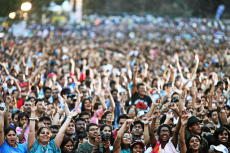
As I’ve mentioned in the past, my particular favourite area of psychology is social psychology. This looks at the effect of others on an individual’s behaviour, and today we’re going to examine how being within a crowd can affect our behaviour, for better or for worse. It may seem like we would act just the same as usual. I mean, we are the same person, but in fact the situation we are in, as has been discussed in previous articles, can have a massive effect on the way we act.
To begin with crowds are interesting, as the term describes a group that come together for a limited period of time but does not specify a precise number of people that make up the group. This suggests that the term in fact does not describe the actual physical properties of the group, but rather the psychological group mentality that comes when a crowd is formed. Some suggest the term implies a common purpose of the group’s members, whereby large groups of people only become crowds when they are united to achieve a goal. The nature of this goal is specific to various different types of crowd. Some crowds are predictable, being governed by a predetermined set of rules or code of conduct. This can result in a peaceful outcome, such as an orderly protest, but when the expected behaviour is still negative, aggressive outcomes can also result. For example, football hooligans will act aggressively because this is often deemed acceptable by society. The outcome can be even more violent when crowds behave unpredictably since they have no set of guidelines. An example of this is rioting and looting, where the police lose their power and so no one knows what is acceptable any more. This is known as a state of anomie.
Originally it was believed that crowds had a primitive mentality where no codes apply, however it is now believed that well-defined codes do exist which limit the behaviour of members of the crowd. It was suggested by Le Bon that crowds have a mental unity, whereby members cease to act as individuals, instead acting as one single mind. Because the individuals are lost in the crowd, they are given an anonymity and lose their individual identities. This makes them suggestible to ‘social contagion’ and soon the behaviour of one will impact on all of the others. In the same way, often, but not always when we see others looking happy, we will adopt a happier persona ourselves. Indeed, it is true that the unified mind of individuals in crowds does not always result negatively. When crowds gather to mourn the death of a royal for example, it is always carried out very solemnly and respectfully. The fact that it is so hard to predict crowd behaviour has in the past resulted in disaster. A tragedy at Hillsborough football stadium led to the deaths of many as they were crushed by police barriers made to control them. This is thought to be down to an assumption made by the police that the crowd would be unreasonable and mob-like, when in fact, the situation could probably have resolved itself quite calmly.
It is for this reason that further research is necessary, as if we can better predict crowd behaviour, we can know how to react to it. In my next article, we’ll look at some specific factors that have been discovered to affect the behaviour of individuals within a crowd.
Image from: http://pup.net.au/gallery/large/ARRahmanConcertCrowd%20.jpg

0 Comment:
Be the first one to comment on this article.